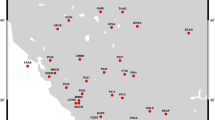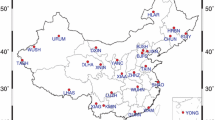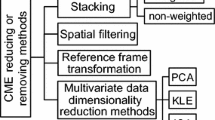Abstract
We present a new method to estimate common-mode components (CMC) in global positioning system (GPS) position time-series. The method (‘CMC Imaging’) is fully automated, relies entirely on robust statistics, and exploits the recent proliferation of GPS stations by allowing stations with relatively short time-series to be considered as filter stations as well. The spatial extent of the CMC is purposely defined as local as possible and constrained by the proximity of nearby GPS stations. Our approach also avoids the need for subjective assignment of filter stations; every station is considered and those stations that deviate significantly from the local CMC are flagged and excluded as filter stations. We study thousands of GPS position time-series in the intraplate area of western Europe, and we show that CMC Imaging method is superior to other approaches in terms of noise reduction: we obtain an RMS reduction of 50%, 44% and 39% in the residual time-series in vertical, east, and north components, respectively. We show the importance of using filter stations that are as local as possible, because of systematic lateral variations in inter-station correlations and indeed in CMC, particularly in the vertical component. Those spatial variations are largest for continental stations, particularly those around the Baltic Sea, and could be due to atmospheric and nontidal ocean loading. CMC filtering has a large influence on reducing the temporal trend variability and approximately doubles the trend accuracy (by comparing variability in short-term trends with the long-term estimate).










Similar content being viewed by others
Code availability
Available upon reasonable request.
References
Amiri-Simkooei AR (2013) On the nature of GPS draconitic year periodic pattern in multivariate position time series. J Geophys Res Solid Earth 118:2500–2511. https://doi.org/10.1002/jgrb.50199
Birkes D, Dodge DY (2011) Alternative methods of regression. Wiley, New York
Blewitt G, Hammond WC, Kreemer C (2018) Harnessing the GPS data explosion for interdisciplinary science. Eos. https://doi.org/10.1029/2018EO104623
Blewitt G, Kreemer C, Hammond WC, Gazeaux J (2016) MIDAS robust trend estimator for accurate GPS station velocities without step detection. J Geophys Res Solid Earth 121:2054–2068. https://doi.org/10.1002/2015JB012552
Blewitt G, Kreemer C, Hammond WC, Goldfarb JM (2013) Terrestrial reference frame NA12 for crustal deformation studies in North America. J Geodyn 72:11–24. https://doi.org/10.1016/j.jog.2013.08.004
Blewitt G, Lavallée D (2002) Effect of annual signals on geodetic velocity. J Geophys Res 107:B72145. https://doi.org/10.1029/2001JB000570
Bogusz J, Gruszczynski M, Figurski M, Klos A (2015) Spatio-temporal filtering for determination of common mode error in regional GNSS networks. Open Geosci. https://doi.org/10.1515/geo-2015-0021
Bowden J, Davey Smith G, Haycock PC, Burgess S (2016) Consistent estimation in Mendelian Randomization with some invalid instruments using a weighted median estimator. Genet Epidemiol 40:304–314. https://doi.org/10.1002/gepi.21965
Brooks BA, Murray J, Svarc J et al (2020) Rapid geodetic observations of spatiotemporally varying postseismic deformation following the Ridgecrest earthquake sequence: the US Geological Survey response. Seismol Res Lett. https://doi.org/10.1785/0220200007
Bruce P, Bruce A (2017) Practical Statistics for Data Scientists: 50 Essential Concepts. O’Reilly Media Inc., Sebastopol
Bruyninx C Defraigne P 2018Bruyninx C, Defraigne P (2018) ROB GNSS Network Data. Available from Royal Observatory of Belgium. Observation Data. https://doi.org/10.24414/FST8-P256
Bruyninx C, Legrand J, Fabian A, Pottiaux E (2019) GNSS metadata and data validation in the EUREF Permanent Network. GPS Solut 23:106. https://doi.org/10.1007/s10291-019-0880-9
de Hoon MJL, Imoto S, Nolan J, Miyano S (2004) Open source clustering software. Bioinformatics 20:1453–1454. https://doi.org/10.1093/bioinformatics/bth078
Devlin SJ, Gnanadesikan R, Kettenring JR (1975) Robust estimation and outlier detection with correlation coefficients. Biometrika 62:531–545. https://doi.org/10.2307/2335508
Devoti R, D’Agostino N, Serpelloni E et al (2017) A combined velocity field of the Mediterranean region. Ann Geophys 60:0215. https://doi.org/10.4401/ag-7059
Dill R, Dobslaw H (2013) Numerical simulations of global-scale high-resolution hydrological crustal deformations. J Geophys Res Solid Earth 118:5008–5017. https://doi.org/10.1002/jgrb.50353
Dong D, Fang P, Bock Y et al (2006) Spatiotemporal filtering using principal component analysis and Karhunen-Loeve expansion approaches for regional GPS network analysis. J Geophys Res 111:B03405. https://doi.org/10.1029/2005JB003806
Dong D, Fang P, Bock Y et al (2002) Anatomy of apparent seasonal variations from GPS-derived site position time series. J Geophys Res 107:ETG9–ETG1. https://doi.org/10.1029/2001JB000573
Fratepietro F, Baker TF, Williams SDP, Camp MV (2006) Ocean loading deformations caused by storm surges on the northwest European shelf. Geophys Res Lett. https://doi.org/10.1029/2005GL025475
Gauss CF (1816) Bestimmung der genauigkeit der beobachtungen. Zeitschrift für Astronomie und verwandte Wissenschaften 1:187–197
Gnanadesikan R, Kettenring JR (1972) Robust estimates, residuals, and outlier detection with multiresponse data. Biometrics 28:81–124. https://doi.org/10.2307/2528963
Gravelle M, Guichard M, Poirier E, et al (2019) Status of SONEL : the GNSS at Tide Gauge Data Assembly Center for the Global Sea Level Observing System (GLOSS). AGU
Griffiths J, Ray JR (2013) Sub-daily alias and draconitic errors in the IGS orbits. GPS Solut 17:413–422. https://doi.org/10.1007/s10291-012-0289-1
Gruszczynski M, Klos A, Bogusz J (2018) A filtering of incomplete GNSS position time series with probabilistic principal component analysis. Pure Appl Geophys 175:1841–1867. https://doi.org/10.1007/s00024-018-1856-3
Guo R, Ahn M, Zhu HZH (2015) Spatially weighted principal component analysis for imaging classification. J Comput Graph Statist 24:274–296. https://doi.org/10.1080/10618600.2014.912135
Hampel FR (1974) The influence curve and its role in robust estimation. J Am Statist Assoc 69:383–393. https://doi.org/10.2307/2285666
Harris P, Brunsdon C, Charlton M (2011) Geographically weighted principal components analysis. Int J Geogr Inf Sci 25:1717–1736. https://doi.org/10.1080/13658816.2011.554838
He X, Hua X, Yu K et al (2015) Accuracy enhancement of GPS time series using principal component analysis and block spatial filtering. Adv Space Res 55:1316–1327. https://doi.org/10.1016/j.asr.2014.12.016
He X, Montillet J-P, Fernandes R et al (2017) Review of current GPS methodologies for producing accurate time series and their error sources. J Geodyn 106:12–29. https://doi.org/10.1016/j.jog.2017.01.004
Huber PJ (1981) Robust statistics. Wiley, New York
Jiang W, Li Z, van Dam T, Ding W (2013) Comparative analysis of different environmental loading methods and their impacts on the GPS height time series. J Geod 87:687–703. https://doi.org/10.1007/s00190-013-0642-3
Johansson JM, Davis JL, Scherneck H-G et al (2002) Continuous GPS measurements of postglacial adjustment in Fennoscandia 1. Geodetic Res J Geophys Res 107:2157. https://doi.org/10.1029/2001JB000400
Johnston G, Riddell A, Hausler G (2017) The International GNSS Service. In: Teunissen PJG, Montenbruck O (eds) Springer Handbook of Global Navigation Satellite Systems. Springer International Publishing, Cham, pp 967–982
King MA, Watson CS (2010) Long GPS coordinate time series: Multipath and geometry effects. J Geophys Res 115:B04403. https://doi.org/10.1029/2009JB006543
Klos A, Bogusz J (2017) An evaluation of velocity estimates with a correlated noise: case study of IGS ITRF2014 European stations. Acta Geodynamica et Geomaterialia 14:261–271
Klos A, Bogusz J, Figurski M, Kosek W (2016) On the handling of outliers in the GNSS time series by means of the noise and probability analysis. In: Rizos C, Willis P (eds) IAG 150 Years. Springer International Publishing, New York, pp 657–664
Klos A, Olivares G, Teferle FN et al (2018) On the combined effect of periodic signals and colored noise on velocity uncertainties. GPS Solut 22:1. https://doi.org/10.1007/s10291-017-0674-x
Kostelecký J, Kostelecký J (2005) New permanent GNSS networks in the Czech Republic and their use in geosciences. Rep Geodesy 2:151–157
Kreemer C, Blewitt G, Davis PM (2020) Geodetic evidence for a buoyant mantle plume beneath the Eifel volcanic area, NW Europe. Geophys J Int 222:1316–1332. https://doi.org/10.1093/gji/ggaa227
Leys C, Ley C, Klein O et al (2013) Detecting outliers: Do not use standard deviation around the mean, use absolute deviation around the median. J Exp Soc Psychol 49:764–766. https://doi.org/10.1016/j.jesp.2013.03.013
Li W, Shen Y (2018) The consideration of formal errors in spatiotemporal filtering using principal component analysis for regional GNSS position time series. Remote Sens 10:534. https://doi.org/10.3390/rs10040534
Lin LI-K (1989) A concordance correlation coefficient to evaluate reproducibility. Biometrics 45:255–268. https://doi.org/10.2307/2532051
Liu B, Dai W, Peng W, Meng X (2015) Spatiotemporal analysis of GPS time series in vertical direction using independent component analysis. Earth, Planets and Space 67:189. https://doi.org/10.1186/s40623-015-0357-1
Liu B, King M, Dai W (2018) Common mode error in Antarctic GPS coordinate time-series on its effect on bedrock-uplift estimates. Geophys J Int 214:1652–1664. https://doi.org/10.1093/gji/ggy217
Márquez-Azúa B, DeMets C (2003) Crustal velocity field of Mexico from continuous GPS measurements, 1993 to June 2001: implications for the neotectonics of Mexico. J Geophys Res 108:2450. https://doi.org/10.1029/2002JB002241
Metsar J, Kollo K, Ellmann A (2018) Modernization of the Estonian national GNSS reference station network. Geodesy Cartogr 44:55–62. https://doi.org/10.3846/gac.2018.2023
Milliner C, Materna K, Bürgmann R et al (2018) Tracking the weight of Hurricane Harvey’s stormwater using GPS data. Sci Adv 4:eaau2477. https://doi.org/10.1126/sciadv.aau2477
Ming F, Yang Y, Zeng A, Zhao B (2017) Spatiotemporal filtering for regional GPS network in China using independent component analysis. J Geod 91:419–440. https://doi.org/10.1007/s00190-016-0973-y
Nikolaidis R (2002) Observation of geodetic and seismic deformation with the Global Positioning System, Ph.D Thesis, Univ. of Calif., San Diego, 305 p. Ph.D. Thesis, Univ. of Calif.
Noll CE (2010) The crustal dynamics data information system: a resource to support scientific analysis using space geodesy. Adv Space Res 45:1421–1440. https://doi.org/10.1016/j.asr.2010.01.018
Ray J, Altamimi Z, Collilieux X, van Dam T (2008) Anomalous harmonics in the spectra of GPS position estimates. GPS Solutions 12:55–64. https://doi.org/10.1007/s10291-007-0067-7
Renka RJ (1997) Algorithm 772: STRIPACK: Delaunay triangulation and Voronoi diagram on the surface of a sphere. ACM Trans Math Softw 23:416–434. https://doi.org/10.1145/275323.275329
RESIF (2017) RESIF-RENAG French national Geodetic Network. RESIF - Réseau Sismologique et géodésique Français. https://doi.org/10.15778/resif.rg
Santamaría-Gómez A, Bouin M-N, Collilieux X, Wöppelmann G (2011) Correlated errors in GPS position time series: Implications for velocity estimates. J Geophys Res 116:B01405. https://doi.org/10.1029/2010JB007701
Santamaría-Gómez A, Mémin A (2015) Geodetic secular velocity errors due to interannual surface loading deformation. Geophys J Int 202:763–767. https://doi.org/10.1093/gji/ggv190
Schenk V, Schenková Z, Cajthamlová M, Fučík Z (2010) GEONAS—Geodynamic network of permanent GNSS stations within the Czech Republic. Acta Geodynam et Geomaterialia 7:99–111
Seitz F, Arenz H, Leismüller F (2014) Position measurements at five permanent GPS stations in the Bavarian Alps as part of the Geodetic Alpine Integrated Network (GAIN) of the ALPS-GPSQUAKENET project. Deutsches Geodätisches Forschungsinstitut der Technischen Universität München
Sen PK (1968) Estimates of the regression coefficient based on Kendall’s Tau. J Am Statist Assoc 63:1379–1389. https://doi.org/10.2307/2285891
Serpelloni E, Faccenna C, Spada G et al (2013) Vertical GPS ground motion rates in the Euro-Mediterranean region: New evidence of velocity gradients at different spatial scales along the Nubia-Eurasia plate boundary. J Geophys Res Solid Earth 118:6003–6024. https://doi.org/10.1002/2013JB010102
Shen Y, Li W, Xu G, Li B (2014) Spatiotemporal filtering of regional GNSS network’s position time series with missing data using principle component analysis. J Geod 88:1–12. https://doi.org/10.1007/s00190-013-0663-y
Shevlyakov G, Smirnov P (2011) Robust estimation of the correlation coefficient: an attempt of survey. Austr J Statist 40:147–156
Shevlyakov GL, Vilchevski NO (2011) Robustness in data analysis, criteria and methods, reprint 2012. De Gruyter, Berlin, Boston
Smith KD, von Seggern D, Blewitt G et al (2004) Evidence for deep magma injection beneath Lake Tahoe, Nevada-California. Science 305:1277–1280
Springer A, Karegar MA, Kusche J et al (2019) Evidence of daily hydrological loading in GPS time series over Europe. J Geod 93:2145–2153. https://doi.org/10.1007/s00190-019-01295-1
Theil H (1950) A rank-invariant method of linear and polynomial regression analysis I. Nederl Akad Wetensch, Proc 53:386–392
Tiampo KF, Mazzotti S, James TS (2012) Analysis of GPS measurements in eastern Canada Using principal component analysis. Pure Appl Geophys 169:1483–1506. https://doi.org/10.1007/s00024-011-0420-1
Tian Y, Shen Z-K (2016) Extracting the regional common-mode component of GPS station position time series from dense continuous network. J Geophys Res Solid Earth 121:1080–1096. https://doi.org/10.1002/2015JB012253
Uhlemann M, Gendt G, Ramatschi M, Deng Z (2016) GFZ global multi-GNSS network and data processing results. In: Rizos C, Willis P (eds) IAG 150 Years. Springer International Publishing, New York, pp 673–679
van Dam T, Collilieux X, Wuite J et al (2012) Nontidal ocean loading: amplitudes and potential effects in GPS height time series. J Geod 86:1043–1057. https://doi.org/10.1007/s00190-012-0564-5
van Dam T, Wahr J, Lavallée D (2007) A comparison of annual vertical crustal displacements from GPS and Gravity Recovery and Climate Experiment (GRACE) over Europe. J Geophys Res Solid Earth. https://doi.org/10.1029/2006JB004335
van Dam TM, Blewitt G, Heflin MB (1994) Atmospheric pressure loading effects on Global Positioning System coordinate determinations. J Geophys Res 99:23939–23950. https://doi.org/10.1029/94JB02122
Wdowinski S, Bock Y, Zhang J et al (1997) Southern California permanent GPS geodetic array: Spatial filtering of daily positions for estimating coseismic and postseismic displacements induced by the 1992 Landers earthquake. J Geophys Res 102:18057–18070
Williams SDP, Bock Y, Fang P et al (2004) Error analysis of continuous GPS position time series. J Geophys Res 109:B03412. https://doi.org/10.1029/2003JB002741
Williams SDP, Penna NT (2011) Non-tidal ocean loading effects on geodetic GPS heights. Geophys Res Lett. https://doi.org/10.1029/2011GL046940
Wu S, Nie G, Liu J et al (2019) A sub-regional extraction method of common mode components from IGS and CMONOC stations in China. Remote Sens 11:1389. https://doi.org/10.3390/rs11111389
Yuan P, Jiang W, Wang K, Sneeuw N (2018a) Effects of spatiotemporal filtering on the periodic signals and noise in the GPS position time series of the Crustal Movement Observation Network of China. Remote Sens 10:1472. https://doi.org/10.3390/rs10091472
Yuan P, Li Z, Jiang W et al (2018b) Influences of environmental loading corrections on the nonlinear variations and velocity uncertainties for the reprocessed global positioning system height time series of the crustal movement observation network of China. Remote Sens 10:958. https://doi.org/10.3390/rs10060958
Zhu Z, Zhou X, Deng L et al (2017) Quantitative analysis of geophysical sources of common mode component in CMONOC GPS coordinate time series. Adv Space Res 60:2896–2909. https://doi.org/10.1016/j.asr.2017.05.002
Acknowledgements
We are extremely grateful to the many agencies, companies, and networks that have made GPS RINEX data available. We specifically thank the following networks and institutions for raw RINEX data: EUREF (Bruyninx et al. 2019), IGS and the many agencies working under its umbrella (Johnston et al. 2017), CDDIS (Noll 2010),Technical University Delft (The Netherlands), NETPOS (The Netherlands), 06-GPS (The Netherlands), LNR Globalcom (The Netherlands), NAM/Shell (The Netherlands), ESTEC (The Netherlands), Royal Observatory of Belgium (Bruyninx and Defraigne 2018), FLEPOS (Belgium), WALCORS (Belgium), Institut Géographique National (France), Réseau GNSS Permanent (France), ORPHEON (France), RENAG (France) (RESIF 2017), SONEL (France) (Gravelle et al. 2019), SPSLux (Luxembourg), Natural Environment Research Council’s British Isles continuous GNSS Facility (United Kingdom), Leica Smartnet (Poland), ASG-EUPOS (Poland), Pecny Observatory (Czech Republic), GEONAS (Czech Republic) (Schenk et al. 2010), VESOG (Czech Republic) (Kostelecký and Kostelecký 2005), CZEPOS (Czech Republic) (Kostelecký and Kostelecký 2005), FreDNet (Italy), Regione Autonoma Friuli Venezia Giulia (Italy), STPOS Bolzano (Italy), Politecnico di Torino (Italy), ARPA Piemonte (Italy), Rete GPS Veneto (Italy), Rete Dinamica Nazionale (Italy), Instituto Nazionale di Geofisica e Vulcanologia (Italy), ITALPOS (Italy), Geodetski Institute (Slovenia), NIEP (Romania), ROMPOS (Romania), ESTPOS (Estonia) (Metsar et al. 2018), LATPOS (Latvia), LITPOS (Lithuania), Danish GPS Center Aalborg (Denmark), Danish Geodata Agency (Denmark), Instituto Geográfico Nacional (Spain), Topcon (Spain), CATNET Catalonia (Spain), GNSS Activa del Principado de Asturias (Spain), Red Activa de Estaciones GNSS de Cantabria (Spain), Red de estaciones GNSS de Castilla y León (Spain), Red Extremeña de Posicionamiento (Spain), Carto Galicia (Spain), REGAM Murcia (Spain), Meristenum Murcia (Spain), Government of La Rioja (Spain), Universidad de Oviedo (Spain), Ayuntamiento de Leganes (Spain), ETSI Topografia Geodesia y Cartografia (Spain), Leica Smartnet (Poland), ASG-EUPOS (Poland), ReNEP—Instituto Geografico Portugues (Portugal), SERVIR (Portugal), Norwegian Mapping Authority (Norway), Norwegian Metrology Service (Norway), SWEPOS (Sweden), Finnish Geodetic Institute (Finland), LIPOS (Austria), SIGNAL (Slovenia), Bundesamt für Kartographie und Geodäsie (Germany), GFZ German Research Centre for Geosciences (Germany) (Uhlemann et al. 2016), Bundesanstalt für Gewässerkunde (Germany), Deutsches Geodätisches Forschungsinstitut (Germany) (Seitz et al. 2014), ASCOS (Germany), and SAPOS networks operated by various German States (i.e., State Office for Spatial Information and Land Development Baden-Württemberg, Hessian State Office for Land Management and Geoinformation, Landesamt für innere Verwaltung Mecklenburg-Vorpommern, Landesvermessung und Geobasisinformation Brandenburg, Staatsbetrieb Geobasisinformation und Vermessung Sachsen, Landesamt für Vermessung und Geoinformation Thüringen, Landesamt für Vermessung und Geobasis Information Rheinland-Pfalz, Bezirksregierung Köln, Geoinformation und Landentwicklung Saarland, and Landesamt für Digitalisierung, Breitband und Vermessung Bayern). ORPHEON GNSS data were provided to the authors for scientific use in the framework of the GEODATA-INSU-CNRS convention. The services of the UK Natural Environment Research Council (NERC) British Isles continuous GNSS Facility (BIGF), www.bigf.ac.uk, in providing archived GNSS data to this project, are gratefully acknowledged. A special thanks to H. van der Marel for helping to make the Kadaster/06-GPS/NAM data in the Netherlands available, A. Araszkiewicz for helping to make the Polish Smartnet data available, E. Nastase for helping to make the Romanian ROMPOS data available, and T. van Dam for helping to make the SPSLux data in Luxembourg available. We are deeply indebted to Yunfeng Tian for applying the CWSF approach to our data set.
Funding
This work got started through financial support to CK from the Royal Dutch Academy of Sciences. Additional support for CK was provided by United States Geological Survey National Earthquake Hazard Reduction Program award G18AP00019 and to CK and GB from National Space and Aeronautics Administration grants NNX16AK89G and 80NSSC19K1044.
Author information
Authors and Affiliations
Contributions
CK designed the study and did all the time-series analysis. GB processed all the RINEX data and produced the time-series. CK wrote the paper, with contributions of GB.
Corresponding author
Ethics declarations
Availability of data and material
Time-series before and after filtering (minus outliers and corrected for offsets) can be found at 10.7910/DVN/ONATFP, and the original time-series at http://geodesy.unr.edu (Blewitt et al. 2018).
Conflict of interest
The authors declare that they have no conflict of interest.
Rights and permissions
About this article
Cite this article
Kreemer, C., Blewitt, G. Robust estimation of spatially varying common-mode components in GPS time-series. J Geod 95, 13 (2021). https://doi.org/10.1007/s00190-020-01466-5
Received:
Accepted:
Published:
DOI: https://doi.org/10.1007/s00190-020-01466-5




